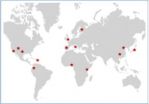(Press-News.org) This month's special issue of Physics World is devoted to animal physics, and includes science writer Stephen Ornes explanation of how pond skaters effortlessly skip across water leaving nothing but a small ripple in their wake.
As Ornes writes, our current understanding of the mechanisms adopted by the pond skater is down to the efforts of David Hu, who as a mathematics graduate from the Massachusetts Institute of Technology spent four years studying their behaviour.
Hu, along with his PhD supervisor John Bush, found that pond skaters use the middle of their three pairs of legs to "row" across the water. When a rowing boat's oar slices the water, it creates swirling vortices just beneath the surface that twist away from the boat and move it forwards – the same vortices are created by tiny hairs that cover the pond skater's legs.
The hairs are the only part of the insect's body that penetrate the water and are covered in a waxy substance that keeps water out by allowing bubbles to attach to them. The hairs have subsequently drawn the attention of materials scientists looking for a permanent waterproofing material that doesn't wash off.
The pond skater (also known as the water strider) is one of a tiny proportion of insects – around 0.1 per cent – that are able to stand and move on water. They stay afloat thanks to their small weight and the surface tension of water acting like a skin; however, according to Newton's third law of motion, the pond skater must push against something to move forward, which is fairly tricky when the only thing available is water.
Previous theories had suggested that pond skaters created tiny ripples – known as "capillary waves" – with their legs which subsequently propelled them across water, but as biologist Mark Denny pointed out in 1993, this couldn't be the case as infant pond skaters cannot move their legs faster than the phase speed of the capillary waves – a feat necessary to create them.
Hu and Bush came to their conclusions by filming a group of pond skaters using high-speed cameras as they moved across a body of water filled with colourful floating particles – this helped identify the swirling vortices that were being created.
David Hu from Georgia Institute of Technology's "laboratory for biolocomotion" will present a special online lecture at 3.00 p.m. GMT on Thursday 8 November 2012, which can be viewed by registering at http://physicsworld.com.
Also in this issue:
Meet the creatures with superpowers -- a set of stunning full-page photos of animals that use physics in quirky ways, including the mantis shrimp, the peacock and the Namib Desert beetle
Why lions roar like babies cry -- vocal scientist Professor Ingo Titze explains what these two sounds have in common and why they're so hard to ignore
How the zebra got his stripes -- the stripy hides of these animals might have evolved to deter biting flies, which prefer all-white or all-black patterns
Lapping it up -- cats appear to drink more elegantly than dogs, but their drinking mechanisms have more in common than their owners might like to think
Fly away home -- how birds navigate using physics-related techniques based on geomagnetism, celestial mechanics, light and sound
Riding raindrops -- how do mosquitos survive being hit by raindrops more than 50 times their own bodyweight, which is equivalent to a human being hit by a black cab?
Vespan voltage -- how the humble hornet uses its in-built solar cell to generate electricity
###
Please mention Physics World as the source of these items and, if publishing online, please include a hyperlink to: http://physicsworld.com
Notes for editors:
1. Physics World is the international monthly magazine published by the Institute of Physics. For further information or details of its editorial programme, please contact the editor, Dr Matin Durrani, tel +44 (0)117 930 1002. The magazine's website physicsworld.com is updated regularly and contains physics news, views and resources. Visit http://physicsworld.com.
2. For copies of the articles reviewed here contact Michael Bishop, IOP press officer, tel +44 (0)11 7930 1032, e-mail michael.bishop@iop.org
3. The Institute of Physics is a leading scientific society promoting physics and bringing physicists together for the benefit of all.
It has a worldwide membership of around 40,000 comprising physicists from all sectors, as well as those with an interest in physics. It works to advance physics research, application and education; and engages with policymakers and the public to develop awareness and understanding of physics. Its publishing company, IOP Publishing, is a world leader in professional scientific communications. Visit http://www.iop.org
Pond skating insects reveal water-walking secrets
2012-11-01
ELSE PRESS RELEASES FROM THIS DATE:
Sleep duration affects hunger differently in men and women
2012-11-01
A new study suggests that increasing the amount of sleep that adults get could lead to reduced food intake, but the hormonal process differs between men and women.
"Restricting sleep in healthy, normal weight participants has limited effects on metabolic risk factors and may affect food intake regulating hormones differently in men and women," said Marie-Pierre St-Onge, PhD, FAHA, the study's principal investigator. "We were surprised by the lack of a significant effect of sleep on glucose and insulin, leptin, and sex differences in the hunger-stimulating hormone ghrelin ...
Scientific team sequences 1,092 human genomes to determine standard range of human genetic variation
2012-11-01
Completing the second phase of the 1000 Genomes Project, a multinational team of scientists reports that they have sampled a total of 1092 individuals from 14 different populations and sequenced their full genomes. The researchers described the feat as a collegial effort to equip biologists and physicians with information that can be used to understand the normal range of human genetic variants so that a patient's disease genome can be interpreted in a broader context.
A report on the research, published online in Nature on Nov. 1 represents the culmination of five years ...
1,000 Genomes Project paints detailed picture of human variation
2012-11-01
HOUSTON -- (Nov. 1, 2012) – First, there was the single human reference genome completed in 2003. Then there was the HapMap project to identify the common genetic variants occurring in human beings with the first map published in 2005. Now an international consortium has released the first phase of the 1,000 Genomes Project that profiles the rare and common genetic variations in 1,092 people drawn from 14 human populations from Europe, Africa, East Asia and the Americas.
The next phase of the project will include as many as 3,000 individuals, said Dr. Fuli Yu (www.bcm.edu/genetics/index.cfm?pmid=23673
), ...
New genetic links for inflammatory bowel disease uncovered
2012-11-01
Crohn's disease (CD) and ulcerative colitis (UC) – inflammatory diseases of the gastrointestinal tract – have puzzled the scientific community for decades. Ten years ago, researchers recognized that both genes and the environment contributed to these diseases but knew little about precisely how and why illness occurred. To begin to narrow in on the key pathways involved, they would need thousands of patients' samples, millions of data points, and the commitment of physicians and scientists at dozens of institutions.
Today, researchers from across the CD and UC communities ...
Fear of math can hurt
2012-11-01
Fear of math can activate regions of the brain linked with the experience of physical pain and visceral threat detection, according to research published Oct 31 by Ian Lyons and colleagues at the University of Chicago in the open access journal PLOS ONE.
The researchers found that in individuals who experience high levels of anxiety when facing math tasks, the anticipation of math increases activity in regions of the brain associated with the physical sensation of pain. The higher an individual's math anxiety, the more such neural activity was increased.
According ...
5 year olds are generous only when they're watched
2012-11-01
Children as young as five are generous when others are aware of their actions, but antisocial when sharing with a recipient who can't see them, according to research published Oct. 31 in the open access journal PLOS ONE by Kristin Lyn Leimgruber and colleagues from Yale University.
Adults are more likely to behave in ways that enhance their reputation when they are being watched or their actions are likely to be made public than when they are anonymous, but this study examines the origins of such behavior in young children for the first time. For their study, the researchers ...
Desert farming forms bacterial communities that promote drought resistance
2012-11-01
When there is little water available for plants to grow, their roots form alliances with soil microbes that can promote plant growth even under water-limiting conditions, according to research published Oct. 31 by Daniele Daffonchio and colleagues from the University of Milan, Italy in the open access journal PLOS ONE.
Symbiotic relationships between plants and soil microbial communities are critical to the health of plants. Though the effects of drought on plants are well-known, little is known about how lack of water affects the bacteria around plant roots.
In this ...
Western aspen trees commonly carry extra set of chromosomes
2012-11-01
A large proportion of aspen in the western U.S. sport an extra set of chromosomes in their cells, a phenomenon termed triploidy, according to new research published Oct. 31 in the open access journal PLoS ONE by Karen Mock from Utah State University and colleagues at several other institutions. In some areas of southern Utah and Colorado, over 60% of aspen trees are triploid.
Though triploid trees are not uncommon, this genetic anomaly can cause altered physical traits including sterility or reduced fertility. Although a triploid aspen clone may reproduce with root ...
Gut reaction: The evolution of IBD
2012-11-01
In one of the largest studies of its kind, researchers have identified 71 genetic regions newly associated with inflammatory bowel disease (IBD), increasing the total number discovered to date to 163. This new information reveals that there is a vast amount of genetic overlap between Crohn's disease and Ulcerative colitis (the two most common subtypes of IBD), suggesting that they share common biological pathways. In addition, analyzing these regions reveals that IBD may result from the body's immune response over-reacting, the result of a long-term evolutionary balancing ...
Do Australia's giant fire-dependent trees belong in the rainforest?
2012-11-01
Australia's giant eucalyptus trees are the tallest flowering plants on earth, yet their unique relationship with fire makes them a huge puzzle for ecologists. Now the first global assessment of these giants, published in New Phytologist, seeks to end a century of debate over the species' classification, a debate which may determine their future.
Gigantic trees are as rare as they are awe inspiring. Of the 100,000 global tree species only 50, less than 0.005%, reach over 70 meters in height. While many of these giants live in Pacific North America, Borneo and similar habitats, ...

